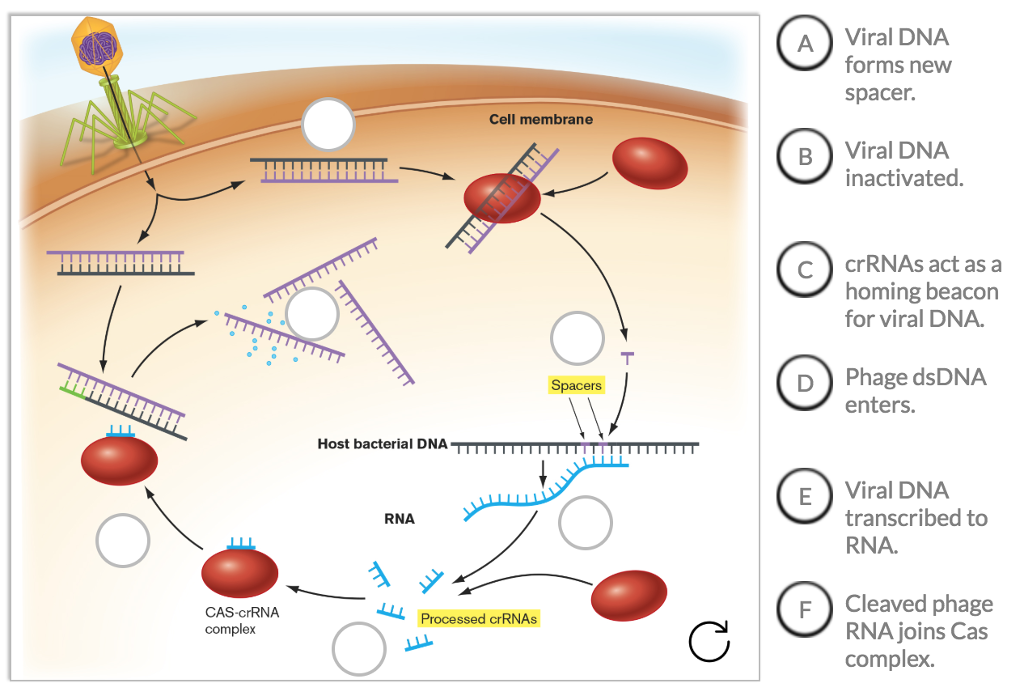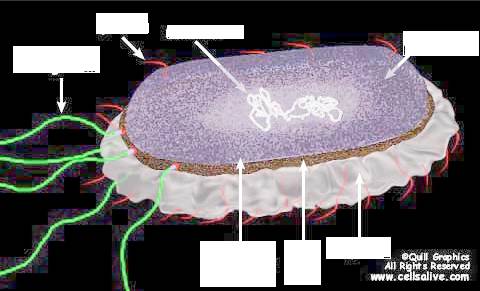45 bacterial cell without labels
Bacterial cell structure - Wikipedia The cell envelope is composed of the cell membrane and the cell wall.As in other organisms, the bacterial cell wall provides structural integrity to the cell. In prokaryotes, the primary function of the cell wall is to protect the cell from internal turgor pressure caused by the much higher concentrations of proteins, and other molecules inside the cell compared to its external environment. Smart food label can identify bacteria without opening the package Smart food label can identify bacteria without opening the package by Victoria Corless | Sep 10, 2020 Food-safe microneedles incorporated into a new smart label can effectively collect samples from packaged food and inform consumers about its quality in real time. Velcro-like food sensor, made from an array of silk microneedles.
Bacteria in Microbiology - shapes, structure and diagram Bacteria cells are the smallest living cells that are known; even though viruses are smaller than bacteria, viruses are not living cells. There are different types of bacteria with various sizes, shapes, and structures. The bacteria shapes, structure, and labeled diagrams are discussed below. Sizes
Bacterial cell without labels
Bacterial cells - Cell structure - Edexcel - GCSE Combined Science ... Bacterial cells Bacteria are all single-celled. The cells are all prokaryotic. This means they do not have a nucleus or any other structures which are surrounded by membranes. Larger bacterial... Label-free bacterial imaging with deep-UV-laser-induced native ... A DUV (<250-nm) source enables the detection of microbes in their native state on natural materials, avoiding background autofluorescence and without the need for fluorescent dyes or tags. We demonstrate that DUV-laser-induced native fluorescence can detect bacteria on opaque surfaces at spatial scales ranging from tens of centimeters to ... Components of Bacterial Cell: 7 Components (With Diagram) ADVERTISEMENTS: The following points highlight the seven important components of bacterial cell. The components are: 1. Cell Envelope 2. Cytoplasm 3. Nucleoid 4. Plasmids 5. Inclusion Bodies 6. Flagella 7. Pili and Fimbriae. Bacterial Cell: Component # 1. Cell Envelope: It is the outer covering of protoplasm of bacterial cell. Cell envelope consists of 3 […]
Bacterial cell without labels. Bacteria: Cell Walls - General Microbiology A cell wall, not just of bacteria but for all organisms, is found outside of the cell membrane. It's an additional layer that typically provides some strength that the cell membrane lacks, by having a semi-rigid structure. Both gram positive and gram negative cell walls contain an ingredient known as peptidoglycan (also known as murein ). Bacterial Cell: Definition, Types, Structure, and Facts Jul 16, 2021 · Bacteria are single-celled microorganisms. The cell structure is less complex than that of different creatures as there are no core or film-bound organelles. A few bacteria have an additional circle of hereditary material called a plasmid. The plasmid frequently contains qualities that give the bacterium some benefit over different bacteria. Bacteria Under The Microscope - Types, Morphology and Reproduction Unlike coccis bacteria, bacillus will appear as elongated rods (rod-like) when viewed under the microscope. In most cases, the bacilli occur as single cells (e.g. Mycobacterium tuberculosis), but may occur in pairs (diplobacillus) or form chains commonly refered to as streptococcus (e.g. Bacillus cereus). Spirilla and V ibrio. Parts Of A Cell Label Teaching Resources | Teachers Pay Teachers The bacterial cell is in color, the individual parts are all shown in red.Includes:10 cards with labels10 cards without labels10 labels1 blackline masterCards with labels are approx. 3¾" x 4", cards without labels are approx. 1" shorter.You may b
Label or Concept - What Is a Pathobiont?: Trends in Microbiology The term ´pathobiont´ has already been widely used to label bacteria that have been linked to a disease merely based on sequence-based correlations with diseased individuals [. 23. Host immunoglobulin G selectively identifies pathobionts in pediatric inflammatory bowel diseases. ]. Breaking free of labels | Nature Reviews Microbiology This month's Under the Lens discusses the use of a novel label-free imaging method to study pilus dynamics at high spatial and temporal resolution. Many pathogenic bacteria are able to crawl along... Bacterial Identification | 8 Methods & Tests In Microbiology Identification by morphology: This method is to determine the individual bacterial physical appearance. 1. Based on size. Here bacteria are identified based on their physical size. Like small size or big one expressed in microns. For this bacteria are viewed under a microscope to view the size. Labeling a bacterial cell 'jacket' - ScienceDaily May 24, 2017 · Labeling the cell 'jacket' Now back to that three to five pounds of bacteria we carry around... Much of the weight comes from the bacteria's cell walls, or "jackets," as Grimes refers to them....
Structure - Medical Microbiology - NCBI Bookshelf Bacterial cells are extremely small and are most conveniently measured in microns (10-6 m). They range in size from large cells such as Bacillus anthracis (1.0 to 1.3 µm X 3 to 10 µm) to very small cells such as Pasteurella tularensis (0.2 X 0.2 to 0.7 µm) Mycoplasmas (atypical pneumonia group) are even smaller, measuring 0.1 to 0.2 µm in diameter. BYJUS Genus Streptobacillus contains gram-negative, aerobic or facultative anaerobic bacteria.Examples are Streptobacillus moniliformis, Streptobacillus felis, etc. Coccobacilli: These are short compared to other bacilli and oval in shape, they appear like a coccus.Examples are Chlamydia trachomatis, Haemophilus influenzae, Gardnerella vaginalis, etc. Bacteria Under the Microscope Bacteria are single-celled organisms that are defined as prokaryotes, these are organisms that have cells with no defined nucleus or other specialized organelles. In total, there are estimated to be millions of species of bacteria, which are diverse in shape, size and many other defining features. 3 Common Bacteria Shapes - ThoughtCo Spirochetes (also spelled spirochaete) bacteria are long, tightly coiled, spiral-shaped cells. They are more flexible than spirilla bacteria. Examples of spirochetes bacteria include Borrelia burgdorferi, which causes Lyme disease and Treponema pallidum, which causes syphilis. Vibrio Bacteria
Bacterial Cell Structure Labeling Diagram - Quizlet Cytoplasm Water-based solution filling the entire cell Ribosomes Tiny particles composed of protein and RNA that are the sites of protein synthesis Nucleoid Composed of condensed DNA molecules. Cell Membrane A thin sheet of lipid and protein that surrounds the cytoplasm and controls the flow of materials in and out of the cell S Layer

Bacterial Cell No Labels Clip Art at Clker.com - vector clip art online, royalty free & public ...
LevitasBio - Unlocking a new dimension in cellular analysis Untouched Label-Free No dyes or labels of any kind required Low pressure, minimizing cell stress Limited cell activation and expression profile distortion See Workflow Simplified Workflow Simple 15 minute, 3 step procedure No additional sample prep, purification, or debris removal required Run-to-run reproducibility without calibration
Introduction to Bacteria - Let's Talk Science Bacterial cells are much smaller than human cells. Bacterial cells can measure from about 1 to 10 μm long. Most of them are only about 1 to 2 μm in diameter. 1 μm, or micrometre, is 1 000 times smaller than a millimetre. That is very tiny! It's much smaller than the human red blood cell, which is (on average) about 7 μm in diameter.
Designer label for a bacterial cell 'jacket' | UDaily Labeling the cell 'jacket' Now back to that three to five pounds of bacteria we carry around... Much of the weight comes from the bacteria's cell walls, or "jackets," as Grimes refers to them. Firm, yet flexible, they are composed of peptidoglycan — a mesh-like polymer made of protein (peptides) and sugar (glycan) molecules.
Bacteria Label Teaching Resources | Teachers Pay Teachers plant, animal and bacteria cell structure with labels to be used as educational art for any kid's playroom, classroom, montessori or homeschooling areas.science printable wall art set of 3 - digital downloadset includes 3 design printables:• plant cell structure chart• animal cell structure chart• bacteria cell structure chartall digital jpeg …
Microbiology Test 2 (Chapter 4: Prokaryotes and Eukaryotes) S. pyogenes is a gram-positive bacterium. Gram-positive bacteria have structural differences that distinguish them from gram-negative organisms. Of particular interest to this case is the fact that these differences in structure can be exploited during treatment. *Drag each of the labels onto the diagram to correctly label the indicated structures.
Bacterial cell structure and function - Online Biology Notes Bacterial cell have simpler internal structure. It lacks all membrane bound cell organelles such as mitochondria, lysosome, golgi, endoplasmic reticulum, chloroplast, peroxisome, glyoxysome, and true vacuole. Bacteria also lacks true membrane bound nucleus and nucleolus. The bacterial nucleus is known as nucleoid.
Bacteriophage - Wikipedia A bacteriophage (/ b æ k ˈ t ɪər i oʊ f eɪ dʒ /), also known informally as a phage (/ ˈ f eɪ dʒ /), is a virus that infects and replicates within bacteria and archaea.The term was derived from "bacteria" and the Greek φαγεῖν (phagein), meaning "to devour".Bacteriophages are composed of proteins that encapsulate a DNA or RNA genome, and may have structures that are either ...
Structure of Bacterial Cell (With Diagram) - Biology Discussion It is 10-25 nm in thickness. It gives shape to the cell. Nucleus: The single circular double-stranded chromosome is the bacterial genome. Other structures include cytoplasmic membrane, mesosomes, ribosomes and cytoplasmic inclusions. Unlike eukaryotes cytoplasm does not contain ribosome, Golgi, cytoskeleton.
Stains - Microbiology Resource Center - Truckee Meadows ... - TMCC Place your needle/loop in the center of the drop and with a spiraling circular motion spread the bacteria on the slide. Set the slide aside to air dry. This will take several minutes at least. Do not rush this step. Fixation The fixation procedure is the same regardless of smear source, plate or broth.
Classical Labeling of Bacterial Pathogens According to Their Lifestyle ... staphylococcus aureus, streptococcus pyogenes, pseudomonas aeruginosa, escherichia coli are typical examples of bacteria which have been labeled extracellular pathogens, and wound infections, osteomyelitis, scarlet fever, certain forms of pneumonia, urinary tract infections are examples of infections caused by these pathogens (nahm et al., 1999; …
Fast label-free identification of bacteria by synchronous fluorescence ... Bacterial cells consist of a very high amount of biological molecules whose content changes in response to different environmental conditions. The similarity between the molecular compositions of different bacterial cells limits the possibility to find unique markers to enable differentiation among species.







Post a Comment for "45 bacterial cell without labels"